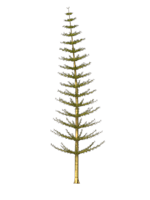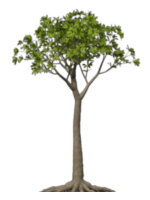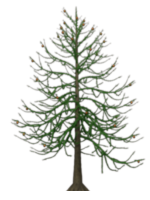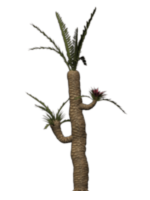Mesozoic Vegetation


Horsetaill

Glossopteris
(Tree Fern)

Araucaria
(Monkey Puzzel)

Williamsonia gigas
(Cycad)
The Food Chain
- The Producer (vegetation) converts sunlight, minerals and water into energy that it uses to grow.
- The Producer is eaten by the Primary Consumer - a vegetarian
- The Primary consumer is eaten by a Secondary Consumer - a carnivore
- The Secondary Consumer may be eaten in turn by a Tetiary consumer - anotehr carnivore
- The Consumers produce waste that de-composes producing minerals for Producers to use - and round it goes.
Triassic
The big extinction event at the end of the Palaeozoic left the Earth relatively devoid of life. The big hole was filled with all sorts of new species. This applied to plants as well as animals.The Triassic saw a huge increase in the numbers of conifers and cycads.
Seed ferns such as Glossopteris and conifers, such as Araucaria were widespread across the Triassic landscape. Palm like Cycads, such as Williamsonia, ferns, mosses and horsetails were also abundant and provided the reasonably small vegetarian dinosaurs of the time with an ample food supply to support them.
At teh start of the Triassic the land was all joined together in a giant super continent called Pangaea. The interior of this continent was dry and rather inhospitable. Life nearer the coast was a little more easy. The Polar regions were free of ice and the climate was warm and temperate. Conifers were fairly dominant in the northern latitudes and ferns were the most dominant in the south.
Jurassic
Conifers were the dominant land plant species of the Jurassic. Huge forests supported herds of giant sauropods like Diplodocus. These giant animals probably had to live a nomadic life travelling on as they exhausted the local food supply of conifers and ginkos. Smaller vegetarians would have feed on low lying vegetation such as Horsetails, ferns mosses and cycads.
There was no polar ice for most of the Jurassic and sea levels were high. As the super continent Pangaea broke up into two main parts, Laurasia in the north and Gondwana in the south, it led to the formation of huge shallow seas areas and chains of small islands.
Around 140 million years ago, at the very end of the Jurassic, flowering plants began to appear.
Cretaceous
The Cretaceous saw a huge change in the life of dinosaurs. Flowering plants had appeared at the end of the Jurassic and spread rapidly to be come the dominant type of the Cretaceous. These new plants were fast growing and were quick to adapt to difficult terrain and demanding conditions. They fuelled a massive expansion in dinosaur numbers and diversity.
Towards the end of the Cretaceous Laurasia and Gondwana continued to break up into smaller continents. The Atlantic Ocean formed and the world began to look a little more like it does today. As the Atlantic widened it affected the weather, which became more and more seasonal. Ice formed at the poles lowering sea levels and introduced more challenges for life. There is evidence that dinosaurs rose to this challenge; living in Antarctica as it broke away from Gondwana in the direction of the South Pole.